


Wing Tsun is the name of a Chinese martial art that specialises in quick and effective self defence. It is a unique fighting system comprised of interrelated principles, techniques and training methods. While "Wing Chun" and "Ving Tsun" are generic names for the style of Kung-Fu as taught by the late Grandmaster Yip Man, "Wing Tsun" describes the art taught by his last closed door disciple, Grandmaster Leung Ting and his International WingTsun Association (IWTA).
The primary function of Wing Tsun is to provide a student with the skills necessary to defend themselves against an all-out attack by a stronger, larger and more aggressive opponent. This scenario is in contrast to martial sports where two athletes of similar size/weight agree to attack each other and where the winner is usually the one who has accumulated the most points. The distinction between the two is important as the characteristics of a self-defence situation are different to that of a competition.
A Wing Tsun practitioner will defend themselves by counterattacking their opponent with rapid, powerful strikes using almost every part of the body. However students are also trained in the appropriate use of force so that a more gentle approach can be applied depending on the situation.
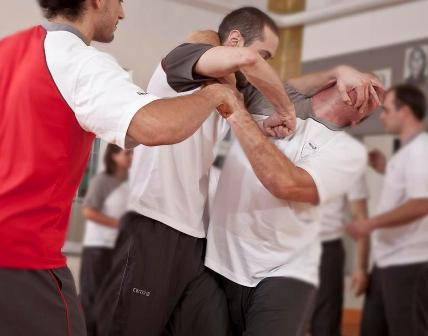
Wing Tsun is not limited to any one range but has strategies and techniques to cover all distances. This includes mid and low level kicks, short range punching, elbow and kneeing techniques, stand up grappling and groundfighting. Also included in the Wing Tsun syllabus are options against multiple attackers and weapons.
Rather than just a collection of easily forgotten and hard to apply techniques, Wing Tsun is instead based on principles. These principles enable the practitioner to follow a clear strategy when attacked and to determine the most appropriate technique to use. In short, when you follow principles, you learn how to think for yourself.
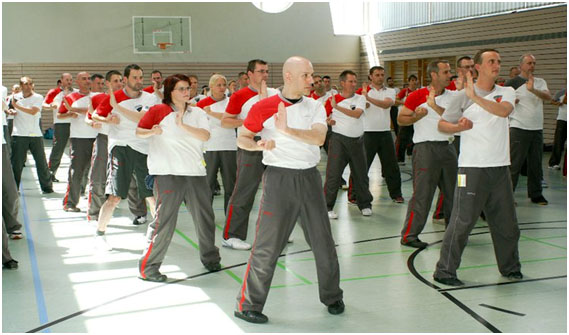
These are sequences of movements which are practiced alone. They contain all the movements/positions in Wing Tsun and like an encyclopedia they help to define the scope of what is included in the system. Wing Tsun forms do not contain techniques. Instead the individual movements are combined in a variety of ways according to Wing Tsun principles to form an unlimited amount of techniques. The forms help to develop coordination with different parts of the body moving in different directions while the body itself acts as one unit. Practice of the forms also prepares the student physically by strengthening and stretching specific muscle groups. The forms also act as mind maps with each movement backed up by a larger amount of underlying information such as principles, mottos, theories, etc. Therefore a lot of information is compressed into Wing Tsun's three empty hand forms which act as a reference point for all further training.
Individual movements are taken from the forms and applied as self-defence techniques according to underlying principles. These applications/techniques are used to defend against all types of attacks such as kicks, punches, elbow/knee strikes, throws, locks, chokes, multiple attackers and defences against weapons.
Lat-Sau describes a drill involving two people where the self-defence applications can be practiced at a higher intensity. Rather than one person stepping in with an attack only when the other person is ready, this drill keeps both people at a very close range where continuous attacks are delivered and defended against in a free flowing manner. One person acts as an attacker and feeds continuous attacks which the defender will react to within the cycle. These attacks are initially pre-determined and delivered at a slow speed however when the defender gains basic proficiency the pace is quickened and the strikes are varied until full force, random attacks can be successfully defended against. This hones the student's skills by keeping the defender focused and forces them to react with better timing. It also desensitises the student to the feeling of panic when confronted with fast, close range, random attacks which are a hallmarks of a real life assault.
Chi-Sau, also known as sticky hands, has been described as the soul of Wing Tsun. It plays a crucial role in enabling the Wing Tsun practitioner to successfully implement the principles of sticking to the opponent, yielding to their greater force or following through if the force is withdrawn. It is an exercise where two people make contact with each others hands and move in a variety of directions. It allows the practitioners to detect the pressure and direction of their opponents force and from there take advantage of any openings to deliver a counterattack.
Where chi-sau is an exercise for the hands, chi-gerk specifically trains the legs. Chi-Gerk is performed by two people, both of whom stand on one foot each. The other foot is raised and stuck to their opponent's leg with both practitioners attacking and defending against their opponents legs. The same principles of chi-sau are applied here, namely sticking to your opponents legs to feel the pressure and direction of their force and should the pressure be too strong, yielding to their force and counterattacking when an opening appears. The ultimate aim is to train both chi-sau and chi-gerk to such a degree so that once a Wing Tsun practitioner is attacked, they will use their arms and legs in a coordinated way to counterattack their opponent without conscious thought.
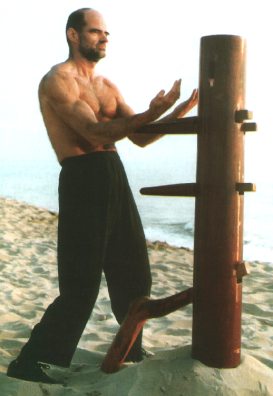
A Wing Tsun wooden dummy is a structure made out of wood which is used to practice a sequence of movements. It is made of a central trunk from which smaller pieces emerge to act as arms and legs. The wooden dummy does not serve to toughen the student's limbs as some think. Instead it provides feedback to ensure the student uses the correct angle when performing movements.Should a student strike the wooden dummy at an incorrect angle they would hurt their arms. However if the correct angle is applied, the wooden dummy can be struck with full force without fear of injury. Training on the wooden dummy will allow the student to perform crisp, clean, powerful movements using the body as one unit.
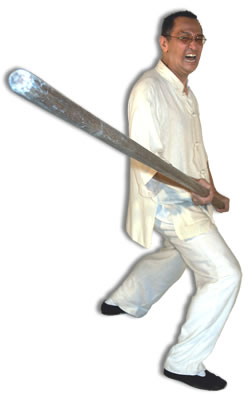
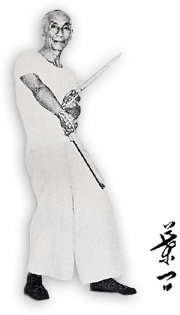
The Wing Tsun system contains training in these two types of weapons. The long pole originated from Hung-Gar Kung Fu style but was modified according to Wing Tsun principles and concepts. Training consists of a long pole form, applications, chi-kwun (sticky pole exercise) and conditioning exercises.
The Wing Tsun knives actually look like small swords however as they have a single edge, according to Kung-Fu terminology, they are called knives. They are called butterfly knives due to the shape they make when placed side by side and traditionally they could be hidden in the sleeves of practitioners. They are a formidable pair of weapons which act as an extension of the body so that the techniques mirror empty hand Wing Tsun movements. Therefore practise of the knives will improve the students empty hand skills.
The WingTsun syllabus has 12 student programmes before the Higher Grades. Each program takes between three to six months to complete, training an average of twice per week. The first two forms, the Siu-Nim Tau and the Chum Kiu are taught and the movements contained within them are combined to form all the techniques that a student is likely to use in a real life self-defence situation. The techniques are introduced individually at first before being practised in the 12 Lat-Sau programmes. Students also start off with Dan-Chi-Sau (Single Hand Chi-Sau)and footwork is then added before the student starts on double hand Chi-Sau using the Poon-Sau (rolling hand) exercise. The student learns how to defend against simple attacks within Poon-Sau before learning the 1st Chi-Sau section. Following the 12th Student Grade the student will move onto the Higher Grades to complete the Wing Tsun system.